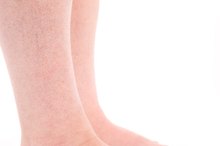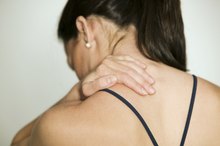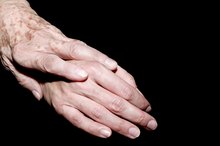What does fact checked mean?
At Healthfully, we strive to deliver objective content that is accurate and up-to-date. Our team periodically reviews articles in order to ensure content quality. The sources cited below consist of evidence from peer-reviewed journals, prominent medical organizations, academic associations, and government data.
- Mayo Clinic: Claudication
- Medline Plus: Sciatica
- Mayo Clinic: Claudication Treatments and Drugs
- Mayo Clinic: Peripheral Neuropathy
The information contained on this site is for informational purposes only, and should not be used as a substitute for the advice of a professional health care provider. Please check with the appropriate physician regarding health questions and concerns. Although we strive to deliver accurate and up-to-date information, no guarantee to that effect is made.
Causes of Burning Calf Pain
If you experience a burning or tingling pain in your calf muscle it may be caused by a number of things. When your calf muscle is overused it can become injured or strained. This can occur from running, walking or other vigorous activities. The burning pain an injury or strain causes may range from mild to severe. Bruising, tightness and swelling can also result from a calf strain. In all cases, this problem should be checked by a doctor.
Claudication
The condition called claudication arises from poor circulation--especially during exercise. Claudication most often affects the blood vessels in your legs but also can spread to your arms. The disorder stems from peripheral artery disease in which the arteries that supply blood to your arms and legs are damaged. Symptoms include pain when exercising, especially in your feet, calves, thighs and hips. You also may experience an aching or burning feeling and pain in your legs even when resting. Depending on the severity of the case, medication or surgery may be options for treatment, according to the Mayo Clinic. Always consult a physician if you suspect you have a medical condition.
- The condition called claudication arises from poor circulation--especially during exercise.
- Claudication most often affects the blood vessels in your legs but also can spread to your arms.
Sciatica
Weak Legs and Constant Stretching at Night
Learn More
Sciatica is characterized by pain or numbness in the back of the leg. According to the National Institutes of Health, most sufferers find pain relief through non-surgical treatments such as physical therapy or prescription drugs. The sciatic nerve runs from your spinal cord to your buttock and down the back of each leg. Sciatica may develop as the result of a herniated disk in your lower back, tumors or a pelvic fracture. Symptoms may include pain in your thigh or calf, lower back or buttock as well as muscle weakness and a tingling feeling in your toes or feet.
- Sciatica is characterized by pain or numbness in the back of the leg.
- Symptoms may include pain in your thigh or calf, lower back or buttock as well as muscle weakness and a tingling feeling in your toes or feet.
Peripheral Neuropathy
Peripheral neuropathy is a condition that is caused by nerve damage. Diabetics most commonly suffer from this problem. According to the Mayo Clinic, other issues that cause this disorder are extreme injuries, infections and exposure to toxins. Symptoms include burning pain, extreme sensitivity and numbness or tingling in the hands or feet. Such symptoms are treatable with medication.
- Peripheral neuropathy is a condition that is caused by nerve damage.
- According to the Mayo Clinic, other issues that cause this disorder are extreme injuries, infections and exposure to toxins.
Related Articles
References
- Wrong Diagnosis: Causes of Calf Burning Sensation
- Mayo Clinic: Claudication
- Medline Plus: Sciatica
- Mayo Clinic: Claudication Treatments and Drugs
- Mayo Clinic: Peripheral Neuropathy
- Chikazawa K, Netsu S, Akashi K, Suzuki Y, Konno R, Motomatsu S. Delayed diagnosis of single compartment muscle contusion after radical hysterectomy in the lithotomy position: A case report. Int J Surg Case Rep. 2016;26:199-201. doi:10.1016/j.ijscr.2016.07.057
- Fields KB, Rigby MD. Muscular Calf Injuries in Runners. Curr Sports Med Rep. 2016;15(5):320-4. doi:10.1249/JSR.0000000000000292
- Freedman BR, Gordon JA, Soslowsky LJ. The Achilles tendon: fundamental properties and mechanisms governing healing. Muscles Ligaments Tendons J. 2014;4(2):245-55.
- Alessandrino F, Balconi G. Complications of muscle injuries. J Ultrasound. 2013;16(4):215-22. doi:10.1007/s40477-013-0010-4
- Picerno V, Filippou G, Bertoldi I, et al. Prevalence of Baker's cyst in patients with knee pain: an ultrasonographic study. Reumatismo. 2014;65(6):264-70. doi:10.4081/reumatismo.2013.715
- Baima J, Krivickas L. Evaluation and treatment of peroneal neuropathy. Curr Rev Musculoskelet Med. 2008;1(2):147-53. doi:10.1007/s12178-008-9023-6
- Petsche TS, Selesnick FH. Popliteus tendinitis: tips for diagnosis and management. Phys Sportsmed. 2002;30(8):27-31.doi:10.3810/psm.2002.08.401
- Stager A, Clement D. Popliteal artery entrapment syndrome. Sports Med. 1999;28(1):61-70. doi:+10.2165/00007256-199928010-00006
- Mcdermott MM. Lower extremity manifestations of peripheral artery disease: the pathophysiologic and functional implications of leg ischemia. Circ Res. 2015;116(9):1540-50. doi:10.1161/CIRCRESAHA.114.303517
- Crum-cianflone NF. Bacterial, fungal, parasitic, and viral myositis. Clin Microbiol Rev. 2008;21(3):473-94. doi:10.1128/CMR.00001-08
- Somford MP, Hoornenborg D, Wiegerinck JI, Nieuwe weme RA. Are You Positive That the Simmonds-Thompson Test Is Negative? A Historical and Biographical Review. J Foot Ankle Surg. 2016;55(3):682-3. doi:10.1053/j.jfas.2016.01.021
- Pulivarthi S, Gurram MK. Effectiveness of d-dimer as a screening test for venous thromboembolism: an update. N Am J Med Sci. 2014;6(10):491-9. doi:10.4103/1947-2714.143278
- Bryan dixon J. Gastrocnemius vs. soleus strain: how to differentiate and deal with calf muscle injuries. Curr Rev Musculoskelet Med. 2009;2(2):74-7. doi:10.1007/s12178-009-9045-8
- Mackman N. Triggers, targets and treatments for thrombosis. Nature. 2008;451(7181):914-8. doi:10.1038/nature06797
- Muir RL. Peripheral arterial disease: Pathophysiology, risk factors, diagnosis, treatment, and prevention. J Vasc Nurs. 2009;27(2):26-30. doi:10.1016/j.jvn.2009.03.001
- American Academy of Orthopedic Surgeons. Muscle Contusion (Bruise). Updated 2014.
- American Physical Therapy Association. Physical Therapist's Guide to Calf Strain. Updated Oct. 17, 2019.
- Childress MA, Beutler A. Management of Chronic Tendon Injuries. Am Fam Physician. 2013 Apr 1;87(7):486-90.
- Grabowski G, Whiteside WK, Kanwisher M. Venous Thrombosis in Athletes. J Am Acad Orthop Surg. 2013 Feb;21(2):108-17.
- Rainbow CR, Fields KB. Calf injuries not involving the Achilles tendon. Fricker P, ed. UpToDate. Updated Feb 7, 2019.
Writer Bio
From Toronto, Elyse Twist began her writing career in 2003. Eager to write about most topics, her main focus is women's issues. She recently had her article about beauty pageant stigmas published in "Post City Magazines." Her articles has also appeared in "Eye Weekly" and "Glow." Twist obtained a Bachelor of Arts, Honors, in professional writing from York University.








